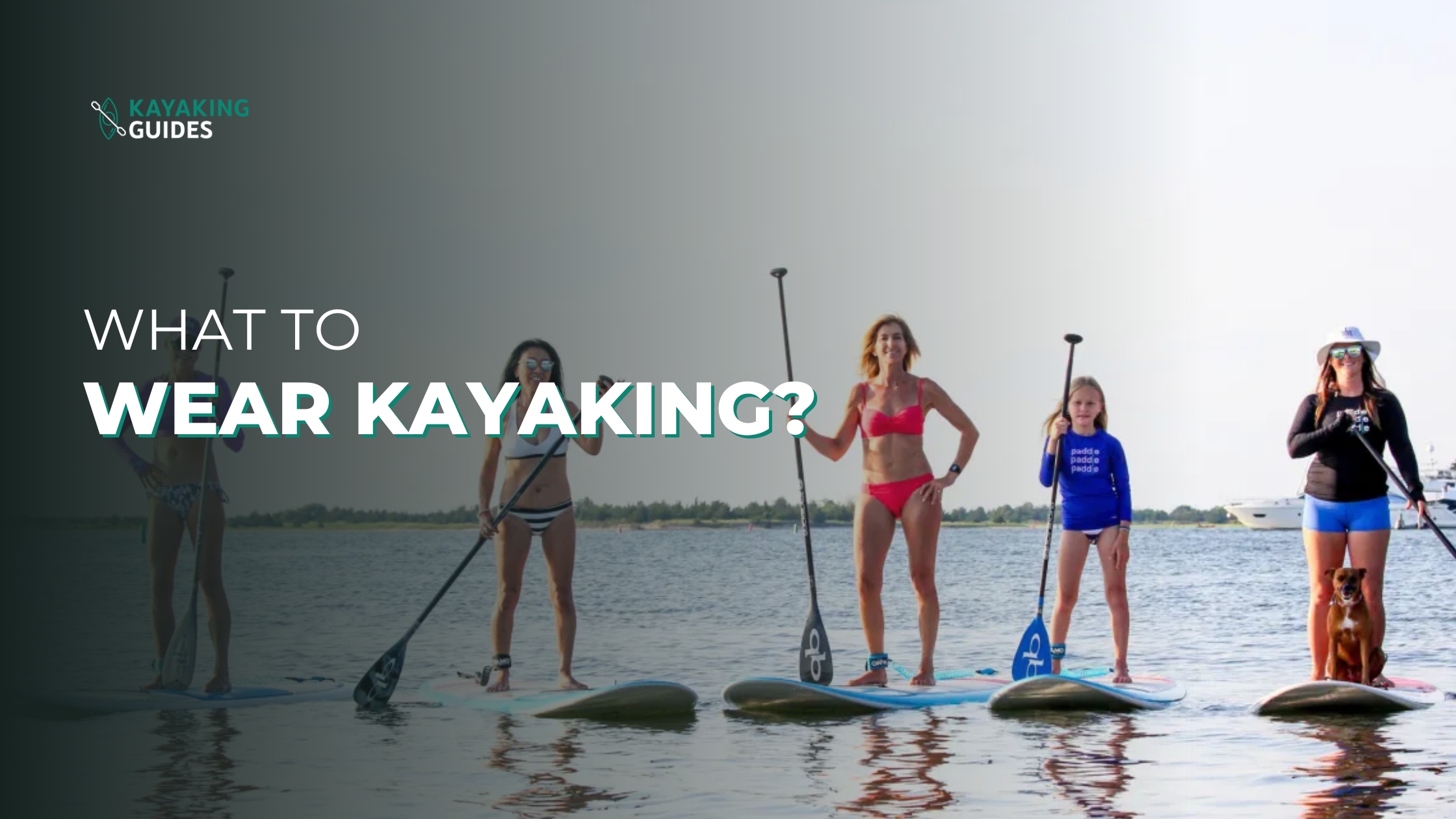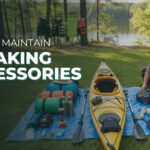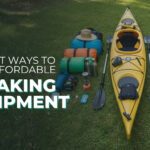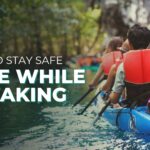Going kayaking soon? Before you grab your paddle, there’s one big question you need to answer: what should you wear?
Many people don’t think about their outfit until they’re already on the water wet, cold or sunburned. The truth is, wearing the wrong clothes while kayaking can leave you uncomfortable, or worse also put you at risk. Water can be cold even on a sunny day, and the weather can change fast.
Don’t worry; we’re here to help! In this guide, you’ll learn exactly what to wear kayaking in any weather or season. Whether you’re paddling on a calm lake in summer or taking on cool rivers in spring or fall, we’ll show you the best clothes to stay safe, dry and comfortable.
From head to toe, you’ll get simple tips, gear advice and easy do’s and don’ts, perfect for beginners or anyone wanting a better kayaking trip.
Let’s dive in!
Why What You Wear Matters While Kayaking
What you wear while kayaking can make a big difference. It’s not just about looking good, it’s about staying safe, dry and comfortable.
When you’re on the water, weather and water temperature can change quickly. If you’re wearing the wrong clothes, you could get too cold, too hot or even soaked. Wet clothes can make your body cold fast, and that’s not safe. In cold water, hypothermia is a real danger even if the sun is out.
Wearing the right outfit helps you move better, paddle easier, and enjoy your trip more. Quick-drying clothes keep you from staying wet, and the right layers protect you from wind, sun or splashes.
The right clothes also help if something goes wrong. If you fall in, it’s much easier to swim or stay afloat when you’re dressed properly.
In short, the right gear keeps you safe and helps you have more fun on the water. That’s why it matters.
What to Wear Kayaking: Essential Clothing Guide
When it comes to kayaking, the best clothes are the ones that keep you dry, warm (or cool) and able to move easily. Here’s a simple guide to what you should wear from top to bottom.
Upper Body Clothing
When kayaking, your upper body needs to stay dry, cool or warm depending on the weather. On hot days, wear a lightweight, long-sleeve shirt made from quick-drying fabric. These shirts help protect your skin from the sun and keep you cool. Look for ones with UV protection to block sunburn. On cooler days, layer your clothes. Start with a base layer that pulls sweat away from your skin. Then, add a warm fleece or thermal shirt. On top, wear a waterproof jacket or paddling top to stay dry from splashes or rain. These layers help keep you safe and comfortable on the water.
Lower Body Clothing
Your legs can get wet and cold while kayaking, so it’s important to wear the right pants. In warm weather, choose quick-dry shorts, swim trunks, or athletic leggings. These dry fast and let you move freely. For colder days, wear thermal leggings or neoprene pants to stay warm. You can also add waterproof pants or dry pants over them to block wind and water. Avoid jeans or cotton pants, they get heavy and cold when wet. Choosing the right bottom layers helps you stay dry, warm, and ready to paddle.
Best Footwear for Kayaking
Your feet need the right shoes when you’re kayaking. Never go barefoot, sharp rocks or sticks can hurt you. Also avoid flip-flops, they slip off easily and don’t protect your feet. Instead, wear water shoes, neoprene booties, or old sneakers that you don’t mind getting wet. These shoes give you grip, protect your feet, and stay on even in water. If the weather is cold, choose neoprene socks to keep your feet warm inside your shoes. The right footwear keeps your feet safe and makes getting in and out of your kayak much easier.
Must-Have Accessories
Small accessories can make a big difference while kayaking. Always wear a hat a wide-brim hat or cap blocks the sun on hot days, and a warm beanie or neoprene hood keeps your head warm in the cold. Sunglasses with a strap protect your eyes from glare and stay on your face if you splash. In cool or windy weather, use paddling gloves to protect your hands and improve your grip. These extra items may seem small, but they help keep you safe, comfortable, and ready for anything on the water.
What NOT to Wear Kayaking
Wearing the wrong clothes while kayaking can make your trip uncomfortable and even unsafe. One of the biggest mistakes is wearing cotton. Cotton gets heavy and stays wet when soaked, which can make you feel cold and slow you down. You should also avoid jeans or thick pants, as they don’t dry quickly and can make it hard to move or sit in the kayak. Flip-flops and bare feet are risky too, they offer no protection and can easily slip off or cause injury on sharp rocks. Even heavy boots are a bad choice because they fill with water and weigh you down if you fall in. Stay away from bulky jackets or coats not made for water. These can get soaked, trap water, and make it hard to paddle. The best rule is to wear clothes made for water ones that are lightweight, quick-drying, and easy to move in. Choosing the wrong outfit can turn a fun adventure into a bad experience, so be smart about what you wear on the water.What NOT to Wear Kayaking
What to Wear Kayaking in Any Weather
What to Wear Kayaking in Winter
Kayaking in winter can be fun, but it’s also cold sometimes very cold! That’s why it’s important to know what to wear kayaking in winter. Start with a dry suit to keep water out and warmth in. Under the dry suit, wear thermal base layers, like fleece or wool. These help you stay warm, even if it’s freezing outside. Wear neoprene gloves, warm socks, and a hat or hood to protect your hands, feet, and head. Cold water can be dangerous, so dress for the water temperature, not just the air. Always wear a life jacket too. Staying warm and dry helps you paddle safely in winter.
What to Wear Kayaking in Summer
When the sun is shining, it’s important to stay cool and protected. If you’re wondering what to wear kayaking in summer, choose light and quick-drying clothes. A long-sleeve UV shirt will protect your skin from sunburn. Wear board shorts, swim leggings, or other water-friendly pants. Don’t forget a hat, sunglasses with a strap, and sunscreen. Water shoes or old sneakers help protect your feet. Even in summer, avoid cotton it stays wet and sticky. The right outfit helps you stay cool, dry, and happy on the water all day long.
What to Wear Kayaking in Spring
Spring weather can change quickly one minute it’s sunny, the next it’s windy or rainy. That’s why you need to plan what to wear kayaking in spring. Start with a moisture-wicking base layer to stay dry from sweat or splashes. Add a light fleece and a waterproof jacket to block wind and rain. Quick-dry pants or waterproof bottoms are smart choices too. Bring gloves, a hat, and sunglasses just in case. Always check the weather before you go, and dress in layers so you can add or remove clothing as needed. Spring kayaking is beautiful when you dress right.
What to Wear Kayaking in Cold Weather
Knowing what to wear kayaking in cold weather is very important for your safety. Even if it’s sunny, cold water can be dangerous. Wear a dry suit or a wetsuit, along with thermal layers to stay warm. Add neoprene boots, gloves, and a warm hat or hood to protect your hands, feet, and head. Avoid cotton, jeans, or bulky jackets they won’t keep you warm or dry. Always dress for the water, not just the air. Cold weather kayaking can be safe and fun if you wear the right clothes and stay prepared.
Conclusion
Wearing the right clothes while kayaking keeps you safe, comfortable, and ready for adventure. Whether you’re paddling in summer heat, spring rain, or cold winter water, it’s important to dress for the weather and the water. Choose clothes that are quick-drying, lightweight, and made for outdoor water use. Avoid cotton, heavy pants, and flip-flops they can make your trip harder and less fun.
Now that you know what to wear kayaking in winter, summer, spring, and cold weather, you can plan your outfit with confidence. Don’t forget key items like a hat, sunglasses, water shoes, and a life jacket. Being prepared means more fun and less worry on the water.
Stay smart, stay safe, and enjoy your kayaking journey!










